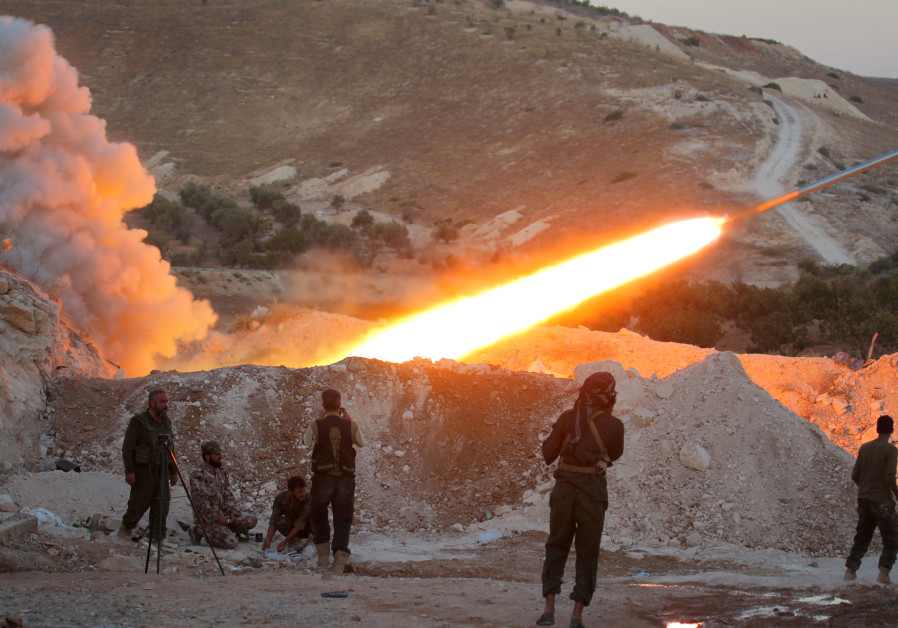Analysis: Who could have been behind the massive explosion in Syria?

Free Syrian Army fighters launch a Grad rocket from Halfaya town in Hama province, towards forces loyal to Syria’s President Bashar Assad stationed in Zein al-Abidin mountain, Syria September 4, 2016. . (photo credit: REUTERS/AMMAR ABDULLAH/FILE PHOTO)
On Sunday night, a massive explosion rocked an area between Homs and Hama in northern Syria. It began with a fire and then a huge explosion, with what appeared to be ammunition shot high in the air, like a horrid fireworks display. Viewers from several areas around filmed it and reports claimed it even registered on seismic charts. The explosion could be seen for many kilometers.
So what happened in Syria? The Syrian regime and its media claimed that military bases came under attack by missiles. According to popular pro-regime Twitter accounts, the details were clear. Explosions struck the 47 Brigade base south of Hama and another area in Aleppo. Immediately, these accounts focused their blame on Israel and said that the base included Islamic Revolutionary Guard Corps members from Iran. They were allegedly stationed in among a grove of trees at a base overlooking the village of Maarin al-Jabal near route M5 from Hama to Homs.
Could Syrian rebels have done it? There are Syrian rebel forces around five kilometers south of the base that blew up. It’s possible that artillery, rocket or mortar fire might be used from their positions. Pro-regime accounts dismissed this, claiming that Russian air assets were active over Idlib and in the area and that, therefore, the rebels wouldn’t use rockets. Of course, Idlib is north of Hama, while the rebel positions near Homs are much closer, but no one seems to have asked about that.
According to the Twitter account of activist Ivan Sidorenko, the casualties at the 47th brigade base included IRGC members from the Zainebiyoun unit of Shi’ite Pakistanis. These are mostly poor Shi’ite recruits sent by Iran to fight in Syria. It’s not clear they were the target, since they were based next to the warehouses—likely full of weapons and ammunition—that blew up.
Four hours after the strikes, around two in the morning, many pro-regime accounts shifted their blame from Israel to the US-led Coalition. The narrative began to form that it was actually a missile strike from the Coalition base at Al-Tanf or from airplanes off the coast with missiles flying over Jordan and striking Hama. Supposedly, the missiles were directed at Iranian bases. A post by Aymenn Jawad al-Tamimi shed light on claims by a commander in the pro-regime Latakia Local Defense Forces, that the strike was “likely an American strike in retaliation for the crossing onto Syrian Democratic Forces positions in Deir ez-Zor.” This is a reference to an attack on April 29 by pro-regime forces on the Euphrates river against US-backed SDF. Other accounts even showed maps and diagrams to “explain” how the attack was carried out by the US. And they sought to show that a US drone was hovering around the Mediterranean at the time of the strikes.
An even more strange rumors put out by some pro-Syrian rebel accounts was that it was the Russians who had targeted their own Iranian allies. “Russia was involved in negotiations in Homs and they wanted to negotiate, and the Astana meetings will take place in two weeks. Because the regime and Iran did not apply the Russian instructions, Russia struck the Iranian base.” Astana is the location of peace talks and the sixth round of discussions between Russia, Turkey and Iran are supposed to take place in mid-May.
By the morning on Monday, the rumors and stories had largely dissipated. Iran’s ISNA news agency reported casualties at the site of the airstrikes. But full details remained unclear and the Iranian media even quoted Israeli media in order to claim that the “Zionists” might have been responsible. Syria’s SANA state media included only a small report on the “foreign aggression” against the base in Hama. It was more interested in boasting about the regime’s successes in battles in southern Damascus against Islamic State and about an agreement to evacuate civilians from a Shi’ite enclave in Idlib.
So why did pro-regime accounts spread rumors blaming the Coalition for the strikes? Why did pro-regime media switch from reporting the “aggression” to ignoring it? It appears that because they knew no one could ignore the massive scale of the explosion, there had to be some explanation. It may have been embarrassing for the regime to assert that Israel had been responsible, because then it would have to admit that Russian air defenses were not activated, despite assertions that future strikes would be challenged. This made it easier for pro-regime activists to create a convoluted and complex story blaming the US for strikes from a “new” location near Jordan. But by the morning, such necessities to blame the US for the strike evaporated into a decision to simply move on. There are still dozens of killed and wounded at the Hama base. Details of their condition and the base itself have yet to emerge.





Comments are closed.